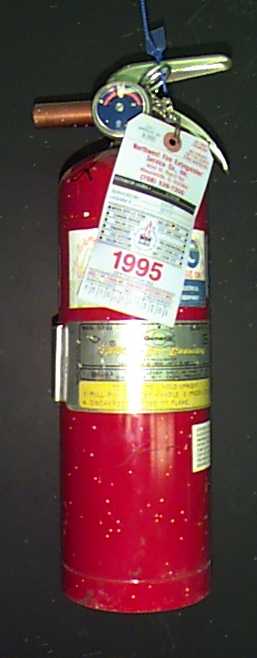|
Watch Out For New Workers...
New employees on the job experience a much greater risk of injury than more experienced
workers. The Bureau of Labor Statistics (BLS) has reported that 40% of workers injured had been on the job less than one year.
In nearly every type of injury, BLS reports the same story is repeated over and over. Workers often do not
receive the safety information they need-even on jobs involving dangerous equipment where training is clearly essential.

Even though our company may be equipped with automatic sprinklers or other means of fire protection, the portable fire extinguisher is the first line of defense in the control of fires at their start.
Most fires, in the beginning stage, can be extinguished easily with portable equipment, but only if the equipment
is readily accessible and the employee knows how to use it. The reaction time, from when the fire is first realized, is extremely
important. If time is wasted in a search for the proper fire extinguisher and a review of the operating instructions, a small,
easily controlled fire will spread in size and intensity. The fire will get out of control and both lives and equipment will be endangered.
A knowledge of the various types of extinguishers and their location in relation to the company layout or
equipment is necessary for quick and effective employee action. This means that extinguishers should reflect the character
of the fire anticipated for the company and its operations. Fire extinguisher locations should be clearly marked and readily
accessible.
An inspection and recharging program should be in place to insure that when an extinguisher is needed, it
is fully charged and operational.
The program will run more effectively if the fire extinguishers are well positioned and clearly marked.
Too many fires have spread because the wrong extinguisher was used, the extinguisher was empty, the employee didnt know
how to operate the extinguisher or the employee could not find an extinguisher in time to be of any help.

Fight Fire before it happens
tips for keeping construction sites fire free
Fueled by drought conditions in the north east, this year's summer
fire season has already been the most devastating on record. Tinder box conditions on many construction sites pose significant
threat of fires being started by an errant spark. These tips will help kep your construction site free from fire.
1. Enforce "no smiking areas" policy throughout the duration of the project.
2. Conduct on-site inspections on a daily basis, including active working areas, material storage areas, locations
with high hazards, construction equipment storage area and the perimeter of the project site.
4. Inspect your fire extinguishers monthly and replaced them if required.
5. Review proper inentification and labeling requirements on flammable liquid and gas containers and cylinders.
For more information, please contact your Safety Director.
|
 |
|
|
 |
|
 |
 |
|
Saving Lives with Lockout/Tagout
The federal lockout/tagout standard published by OSHA in 1989 was designed to prevent injuries and deaths caused by accidental
start-up of equipment during maintenance or servicing. OSHA estimates that the lockout/tagout standard saves 122 lives and
prevents 28,000 lost workday injuries each year. It's likely that well over 800 lives have been saved since the standard went
into effect. That's more than 800 people who still go home to their families, friends, and loved ones; people who are there
for the ones who depend on them. The lockout/tagout standard works. It saves lives. Yet unfortunate tragedies do still occur,
but many of them could be prevented if the lockout/standard is applied correctly.
The lockout/tagout standard requires that hazardous energy sources be "isolated and rendered inoperative" before maintenance
or servicing work can begin. These energy sources include electrical, pneumatic, hydraulic, mechanical, thermal, chemical,
and the force of gravity. It is important to remember all of the energy sources must be "isolated and rendered inoperative."
Overlooking an energy source has proved fatal on several occasions.
In order to "isolate and render inoperative" an energy source, an energy isolating device must be locked in place, or in
certain cases, labeled with a tag warning against start-up of the equipment until servicing is finished. Stored energy sources,
such as pressure, springs, and electricity contained in capacitors, must be released or "otherwise rendered safe" before servicing
the equipment. Every person who will be working on the equipment applies a lock or tag to each energy isolating device. For
complex equipment with many energy sources a group lockout is permitted.
After locks are applied, an attempt to re-start the equipment must be made to verify the equipment cannot be restarted
before servicing begins. After servicing, each person who placed a lock or tag must remove it before the equipment is started.
|
 |
|
|
|



